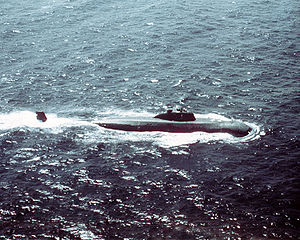This article needs additional citations for verification. (August 2021) |
 A Victor I-class submarine underway
| |
| Class overview | |
|---|---|
| Name | Victor class |
| Builders | Sudomekh Shipyard |
| Operators | |
| Preceded by | November class |
| Succeeded by | Alfa class, Akula class |
| In commission | 1967–present |
| Completed | 48[1] |
| Active | 2 |
| Retired | 46 |
| General characteristics | |
| Type | Nuclear attack submarine |
| Displacement |
|
| Length | 93–102 m (305 ft 1 in – 334 ft 8 in) |
| Beam | 10 m (32 ft 10 in) |
| Draft | 7 m (23 ft 0 in) |
| Propulsion | One VM-4P pressurized-water twin nuclear reactor (2x75 MW), 2 sets OK-300 steam turbines; 1 7-bladed or 2 4-bladed props; 31,000 shp (23,000 kW) at 290 shaft rpm – 2 low-speed electric cruise motors; 2 small props on stern planes; 1,020 shp (760 kW) at 500 rpm Electric: 4,460 kw tot. (2 × 2,000-kw, 380-V, 50-Hz a.c. OK-2 turbogenerators, 1 × 460-kw diesel emergency set)[verification needed] |
| Speed | 32 knots (59 km/h; 37 mph) |
| Endurance | 80 days |
| Complement | About 100 (27 officers, 34 warrant officers, 35 enlisted) |
| Sensors and processing systems |
|
| Armament |
|
The Victor class, Soviet designations Project 671 Yorsh, Project 671RT Syomga and Project 671RTM/RTMK Shchuka, (NATO reporting names Victor I, Victor II and Victor III, respectively), are series of nuclear-powered attack submarines built in the Soviet Union and operated by the Soviet Navy. Since the 1960s, 48 units were built in total, of which the last remaining are currently in service with the Russian Navy. The Victor-class submarines featured a teardrop shape, allowing them to travel at high speed. These vessels were primarily designed to protect Soviet surface fleets and to attack American ballistic missile submarines. Project 671 began in 1959 with the design task assigned to SKB-143 (one of the predecessors of the Malakhit Marine Engineering Bureau).
- ^ Includes all three Victor classes.